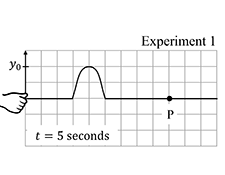
Reflection and transmission of pulses
Variant i Interactive tutorial lecture Other Variants Dynamics first
Students observe pulses that reach a boundary between two different springs and draw on observations to construct a model for reflection and transmission from a boundary.
Topics Waves and optics / Waves: boundary conditions, limits, models, fixed end reflection, free end reflection, linear mass density, reflection/transmission at a boundary, tension, wave (or pulse) speed, and superposition
Materials
Materials by the UW team
- Clicker Questions Only


- Instructor Guide


- Pretest



- Pretest for LMS



- Exam Questions



- Equipment List

Tutorial details
Section I: Pulses on a spring
In this section, students consider a pulse on a spring generated by a hand. They determine the speed at which the pulse moves and explore how increasing the tension in the spring affects the speed and shape of the pulse. In Question D, they determine the changes that could be made to the experiment in order to create a narrower pulse.
Section II: Behavior of pulses at a boundary
Students are shown a time sequence of photographs that illustrates the behavior of two springs joined end-to-end when a pulse reaches the boundary between them. They then compare the wave speeds, tensions, and linear mass densities of the springs. Lastly, they explore the behavior of the pulse as it approaches the boundary from the opposite end of the spring.
Section III: A model for reflection at a boundary
Students they are led to recognize that the relative linear mass densities of two connected springs (or the relative wave speeds) can be used to determine whether the reflection at the boundary behaves more like that from a fixed end or from a free end.
For instruction tips, login or register as a verified educator to see the Instructor Guide.
Prerequisites
Prerequisite tutorials
The Superposition of pulses tutorial is a prerequisite to Reflection and transmission of pulses.
Other prerequisites
This tutorial builds on the tutorial Superposition and reflection of pulses. Students must be familiar with the relationship between the wave speed, the tension in the spring, and the linear mass density of the spring.
Research
- M. Kryjevskaia, M. R. Stetzer, and P. R. L. Heron, Student difficulties measuring distances in terms of wavelength: Lack of basic skills or failure to transfer?, Phys. Rev. ST Phys. Educ. Res. 9 (1) 010106 (2013).
- M. Kryjevskaia, M. R. Stetzer, and P. R. L. Heron, Student understanding of wave behavior at a boundary: The limiting case of reflection at fixed and free ends, 79 (5) 508-516 (2011).
- M. Kryjevskaia, M. R. Stetzer, and P. R. L. Heron, Student understanding of wave behavior at a boundary: The relationships among wavelength, propagation speed, and frequency, Am. J. Phys. 80 (4) 339-347 (2012).
Coming Soon! We hope to release the discussion section on each tutorial soon.

